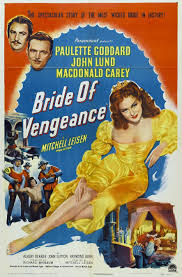THE CHALICE FROM THE PALACE
It’s hard to know how seriously to take Bride of Vengeance. Faced with the need to recreate the pomp and pageantry of 16thcentury Italy on some poky Hollywood sets, and with a cast from the Paramount second string to impersonate the Borgias, Mitchell Leisen must have been tempted to throw up his hands, particularly after the scheduled lead, Ray Milland, preferred two months of unpaid suspension rather than play the lead role of Alfonso D'Este, Duke of Ferrara. Milland claimed to dislike both the film’s original title, “A Mask for Lucretia”, and the script, and would rather ski and sail for eight weeks; manly pursuits that didn’t require him to appear in....well, frocks. (Milland couldn’t carry off robes and hose, and never played in anything set earlier than the Regency.)
It’s hard to know how seriously to take Bride of Vengeance. Faced with the need to recreate the pomp and pageantry of 16thcentury Italy on some poky Hollywood sets, and with a cast from the Paramount second string to impersonate the Borgias, Mitchell Leisen must have been tempted to throw up his hands, particularly after the scheduled lead, Ray Milland, preferred two months of unpaid suspension rather than play the lead role of Alfonso D'Este, Duke of Ferrara. Milland claimed to dislike both the film’s original title, “A Mask for Lucretia”, and the script, and would rather ski and sail for eight weeks; manly pursuits that didn’t require him to appear in....well, frocks. (Milland couldn’t carry off robes and hose, and never played in anything set earlier than the Regency.)
 |
| John Lund (centre), Paulette Goddard |
One can see why they cast Milland. Alfonso is not too far from the superficially effete lawyer he played in Reap the Wild Wind. Under its tesselated floors, omnipresent statuary, staircases and velvet hangings, Bride of Vengeance is a sex comedy, with elements of The Scarlet Pimpernel andZorro. Convinced by Cesare Borgia that Alfonso killed her husband, Lucretia is married off to him with the sole aim of murdering him and surrendering Ferrara to her brother. Playing the fop and fool, Alfonso neglects her to sneak off to his secret foundry, where he’s building an enormous cannon. His first few tries are duds -well, he’s new to this - but once Lucretia adds her expertise, the two experience a highly satisfying explosion.
What probably irked Milland more than the schmutter was the presence front and centre of Paulette Goddard as Lucretia Borgia. Eyes wide, teeth bared, and made up like a wicked sister in a pantomime Cinderella, she’s in almost every scene, and goes for the jugular in all of them. At times, the inoffensive John Lund as Alfonso, switched, after Milland’s defection, from his role as Cesare Borgia (John Lund - as Cesare Borgia??) looks in fear of his life. Maybe it’s only the contrast, but Macdonald Carey as Cesare is almost convincing, mostly because his political persona is submerged in some incestuous clinches with his sister.
At 38, however, Goddard is simply too old for this foolery. The film terminated her time at Paramount. Within a few years she’d be reduced to Babes in Bagdad and Vice Squad, before disappearing into television – the fate also of Macdonald Carey, shortly to become a king in daytime drama.
That the script derives from a story called Chalice called instantly to mind Norman Panama and Mel Frank’s classic “Chalice from the palace” routine from The Court Jester. For those who haven’t seen it, the characters use a mnemonic to remind them which is the fatal cup (“The vessel with the pestle/Has the potion with the poison”), only to become confused when plans change (“It’s the flagon with the dragon...”) Incidentally, Panama and Frank first wrote it in 1948 for Red Skelton in A Southern Yankee, where something is secreted in a jacket with the placket. No doubt it appears first in a rip-off of Ralph Roister Doister and a rhyme about “Ye firkin with a jerkin” recited by the brothers Bollocks to Scrotum, a wrinkled old retainer.
There’s so little to involve one in Bride of Vengeance that such random thoughts are unavoidable. One automatically recalls how much Orson Welles did with even fewer resources in Othello. An opening like his silhouetted funeral on the battlements would have lifted this one immeasurably. (And let’s not forget how imposing a Cesare Welles made in Prince of Foxes.) But Leisen is a director of interiors, so except for an occasional cut-away the film hasn’t a single scene set outside. Instead, he expends his energies on staging, and on the costumes, for the design of which he receives co-credit. Everything in the film looks back to his early career as Cecil B. DeMille’s costumier, a history that elicited from Billy Wilder the sneering insult “Window dresser!” Well, perhaps. Though with Leisen it’s not so much the windows as the bizarre nature of the life glimpsed through them.
Editor's Note: John Baxter first wrote on the career of Mitchell Leisen in Film Digest, published by the WEA Film Group in Sydney in the sixties. The essay drew an approving letter to the editor from Leisen himself. The edition is now a collector's item though it is always possible a copy may be held by Sydney's best kept secret bookshop Badger Books
Editor's Further Notes: John Baxter recently published a piece on Leisen's 1934 Murder at the Vanities. You can read it if you click here A very good quality copy of Bride of Vengeance can be viewed free on a streaming service if you click here



No comments:
Post a Comment
Note: only a member of this blog may post a comment.